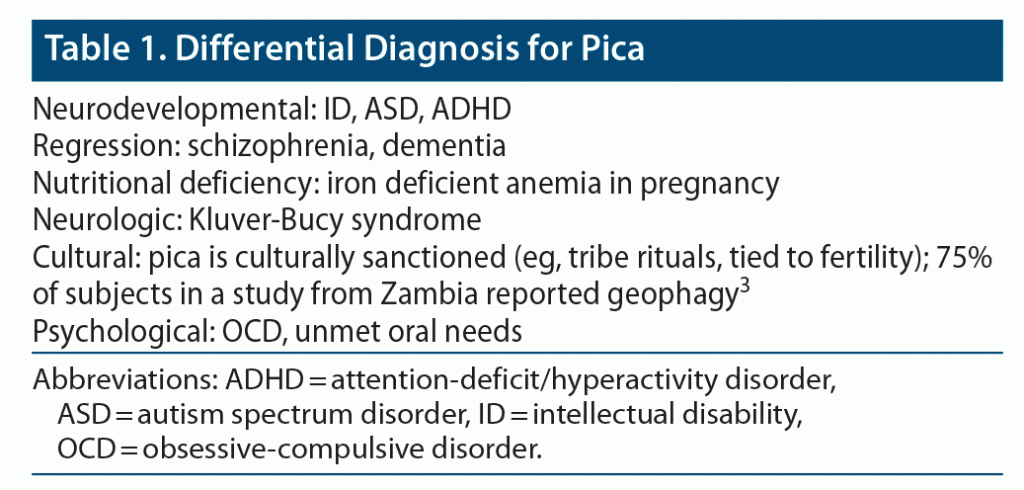
Prim Care Companion CNS Disord 2021;23(4):20l02757
To cite: Naguy A. ADHD masquerading as cautopyreiophagia exacerbated by risperidone and improved with methylphenidate in a preschooler. Prim Care Companion CNS Disord. 2021;23(4):20l02757.
To share: https://doi.org/10.4088/PCC.20l02757
© Copyright 2021 Physicians Postgraduate Press, Inc.
aAl-Manara CAP Centre, Kuwait Centre for Mental Health, Shuwaikh, Sulibikhat, Kuwait
*Corresponding author: Ahmed Naguy, MBBch, MSc, Kuwait Centre for Mental Health, Jamal Abdul-Nassir St, Shuwaikh, Sulibikhat 21315, Kuwait ([email protected]).
The DSM-5 defines pica as the consumption of non-nutritive, nonfood substances for a period > 1 month. Here, the case of a 4-year-old boy with behaviors consistent with pica is presented.
Case Report
A 4-year-old Kuwaiti boy was referred from the developmental pediatrics outpatient department as an unusual case of pica. He had the habit of eating burnt matchsticks (cautopyreiophagia), paper (xylophagia), and geophagia of a few months duration. This behavior was only recently discovered after multiple emergency department visits for unexplained recurrent abdominal pain. Developmental assessment using the Wechsler Preschool and Primary Scale of Intelligence1 revealed the following results: full scale intelligence quotient: 88 (in the low average range), verbal comprehension: 81, visual spatial: 91, fluid reasoning: 85, working memory: 84, and processing speed: 92. Baseline laboratory workup including iron studies, vitamin D level, and thyroid function tests were all within normal limits. Blood film, lead levels, and erythrocyte protoporphrin were unrevealing. Electroencephalogram showed generalized epileptiform discharges. Applied behavioral analysis was suggested but was not helpful. Review of parental reports as well as kindergarten records demonstrated attention-deficit/hyperactivity disorder (ADHD)–like disruptive behaviors including risk-taking behaviors (eg, dashing out into the road, throwing severe tantrums, repeated minor head trauma). Autism spectrum disorder and obsessive-compulsive disorder were ruled out on clinical grounds. Given the safety concerns, a trial of risperidone was suggested. Risperidone 0.75 mL/d over 2 weeks resulted in tangible behavioral improvement, but paradoxical exacerbation of pica was also reported along with increased appetite. The boy’s parents requested to discontinue risperidone, as his serum prolactin level was elevated at follow-up. He was switched to methylphenidate immediate release 2.5 mg once daily, which was titrated to 3 times daily over 1 week (weight: 19 kg/42 lb). A remarkable behavioral response was reported, but, most importantly, the pica dramatically improved. Twelve weeks have elapsed at the time of this writing, and he continues to do well with no evidence of pica. Methylphenidate response was achieved with great tolerability.
Discussion
The developmental age for pica is ≥ 2 years. The eating behavior should not be culturally sanctioned.2 The differential diagnosis for pica is provided in Table 1.3
Although ADHD has been associated with comorbid eating disorders, especially bulimia nervosa,4 association with pica as in this case is limited to only case reports.5–7
Pica might be related to dopamine dysregulation. In a double-blind randomized placebo-controlled trial8 evaluating the hypothesis that pica may be exacerbated by the use of antipsychotics, when compared to placebo, all 3 subjects engaged in higher levels of pica during the thioridazine phase. These subjects showed improvement in pica after methylphenidate (mechanistically a DA agonist).8 Pica was reported following commencement of the atypical antipsychotics risperidone and olanzapine in 2 cases.9 Pica was also reported to be responsive to aripiprazole (partial dopamine agonist).10 The differential effects of methylphenidate and atypical antipsychotics on appetite might be contributory.11
As this case illustrates, clinicians should be vigilant to probe executive dysfunction (eg, ADHD) in occasional instances of neurotypically developing children presenting with pica that cannot be accounted for by major psychopathology or nutritional deficiency. Use of stimulants in these scenarios is then warranted, while high-potency antipsychotics are better avoided.
Published online: July 1, 2021.
Potential conflicts of interest: None.
Funding/support: None.
Patient consent: Informed consent was obtained from the patient’s parents to publish the case report, and information has been de-identified to protect anonymity.
References (11)

- Wechsler D. Wechsler Preschool and Primary Scale of Intelligence–Revised. San Antonio, TX: The Psychological Corporation; 1989.
- Gupta N, Toteja N, Sasidharan R, et al. Behind the façade of sapophagia: role of psychosocial factors in early childhood. Asian J Psychiatr. 2020;49:101956. PubMed CrossRef
- Nchito M, Geissler PW, Mubila L, et al. Effects of iron and multimicronutrient supplementation on geophagy: a two-by-two factorial study among Zambian schoolchildren in Lusaka. Trans R Soc Trop Med Hyg. 2004;98(4):218–227. PubMed CrossRef
- Ziobrowski H, Brewerton TD, Duncan AE. Associations between ADHD and eating disorders in relation to comorbid psychiatric disorders in a nationally representative sample. Psychiatry Res. 2018;260:53–59. PubMed CrossRef
- Hergüner S, Hergüner AS. Pica in a child with attention deficit hyperactivity disorder and successful treatment with methylphenidate. Prog Neuropsychopharmacol Biol Psychiatry. 2010;34(6):1155–1156. PubMed CrossRef
- Saddichha S, Vibha P, Vishnuvardhan G. Sapophagia (compulsive soap eating) and attention-deficit/hyperactivity disorder in a child responsive to clonidine. J Clin Psychopharmacol. 2012;32(2):291. PubMed CrossRef
- Gunes H, Tanidir C, Adaletli H, et al. Effect of methylphenidate on impulsivity in a child with pica and attention deficit hyperactivity disorder. Bulletin of Clinical Psychopharmacology. 2016;26(1):87–88. CrossRef
- Singh NN, Ellis CR, Crews WD Jr, et al. Does diminished dopaminergic neurotransmission increase pica? J Child Adolesc Psychopharmacol. 2009;4(2):93–99. CrossRef
- Chawla N, Charan D, Kumar S, et al. Pica associated with initiation of atypical antipsychotic drugs: report of two cases. Psychiatry Clin Neurosci. 2016;70(8):363–364. PubMed CrossRef
- Hergüner A, Hergüner S. Pica in an adolescent with autism spectrum disorder responsive to aripiprazole. J Child Adolesc Psychopharmacol. 2016;26(1):80–81. PubMed CrossRef
- Naguy A, Hashem MS, AlKhadhar S. Atypical antipsychotics for attention-deficit/hyperactivity disorder- science, art, or fad? Eur Psychiatry. 2019;62:58–59. PubMed CrossRef
Please sign in or purchase this PDF for $40.




